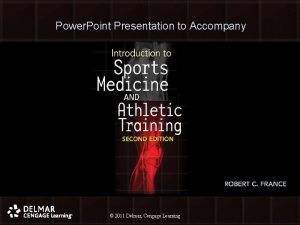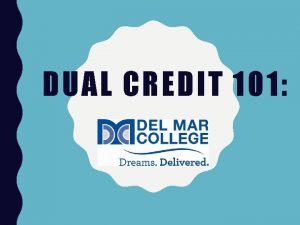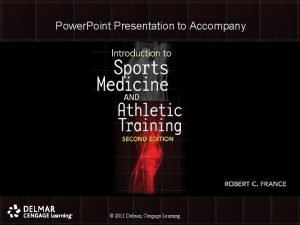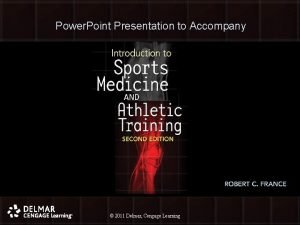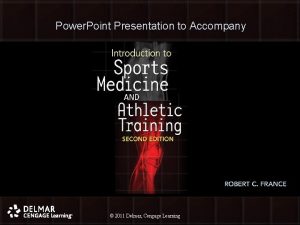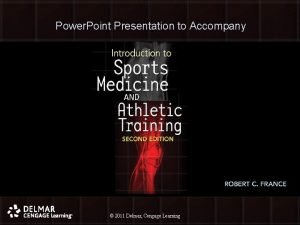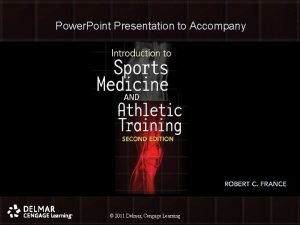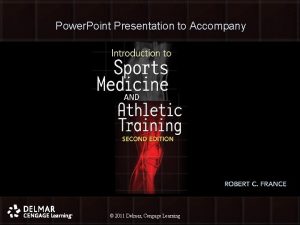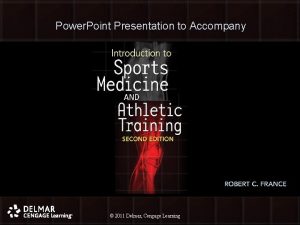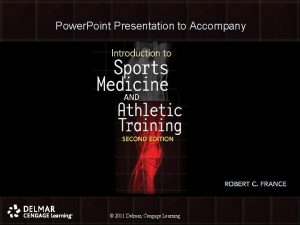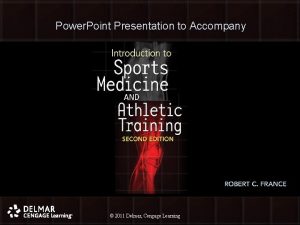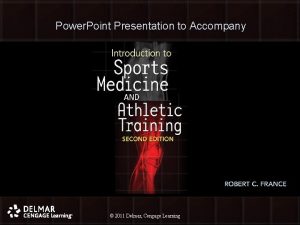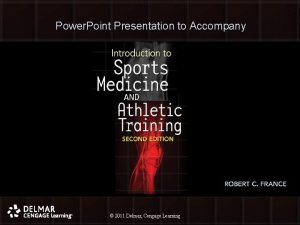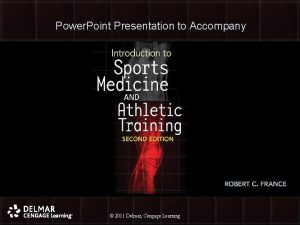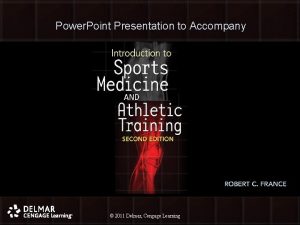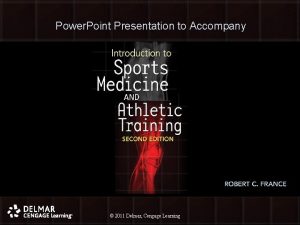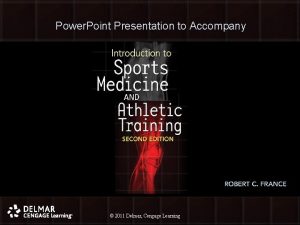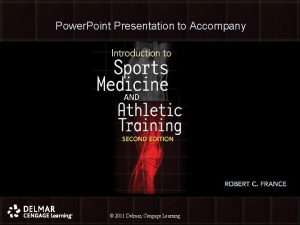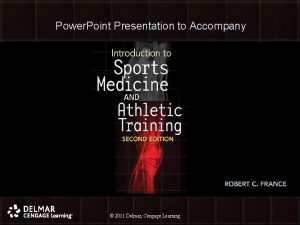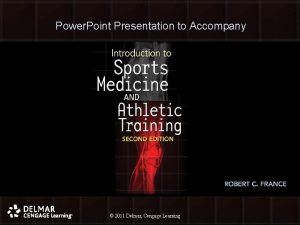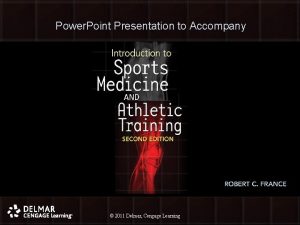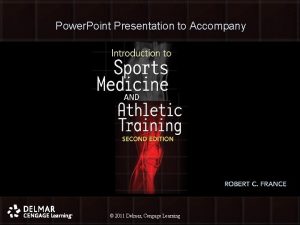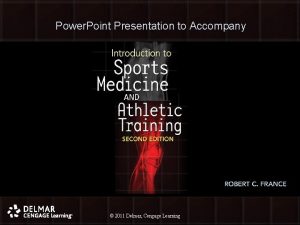Power Point Presentation to Accompany 2011 Delmar Cengage























- Slides: 23

Power. Point Presentation to Accompany © 2011 Delmar, Cengage Learning © 2010 Delmar, Cengage Learning

Chapter 7 Prehabilitation and Preseason Conditioning © 2011 Delmar, Cengage Learning © 2010 Delmar, Cengage Learning 2

Objectives • Upon completion of this chapter, you should be able to: – Discuss how prehabilitation can decrease the chance of injury – Explain how preseason conditioning helps the body adapt to the demands placed upon it – Describe isometric, dynamic, and isokinetic exercise and how they are used in a conditioning program © 2011 Delmar, Cengage Learning © 2010 Delmar, Cengage Learning 33

Objectives (cont’d. ) • Upon completion of this chapter, you should be able to (cont’d. ): – Compare and contrast manual resistance training, circuit training, and special individualized programs – Describe the science behind progressive resistance exercise © 2011 Delmar, Cengage Learning © 2010 Delmar, Cengage Learning 44

Objectives (cont’d. ) • Upon completion of this chapter, you should be able to (cont’d. ): – Explain how stretching and flexibility are important components of an overall fitness program – Explain the benefits of cardiorespiratory training © 2011 Delmar, Cengage Learning © 2010 Delmar, Cengage Learning 55

Prehabilitation • Rehabilitation: – Programmed exercise program designed to return an athlete to fitness and competition • Prehabilitation: – Trying to prevent injuries before they occur, through a preventative management program © 2011 Delmar, Cengage Learning © 2010 Delmar, Cengage Learning 66

Preseason Conditioning • Developing the athlete in the off-season – Athletes work on overall conditioning as well as concentrating on specific weaknesses • Preseason conditioning program – Begin six to eight weeks prior to sports participation • Allows body to gradually adapt to demands © 2011 Delmar, Cengage Learning © 2010 Delmar, Cengage Learning 77

Preseason Conditioning (cont’d. ) • Sports medicine physicians, certified athletic trainers, and qualified youth coaches prescribe preseason conditioning programs – Provide athletes with information on the type, frequency, intensity, and duration of training © 2011 Delmar, Cengage Learning © 2010 Delmar, Cengage Learning 88

Strength Training • Body changes in response to increased training load – Highly adaptive – Requires a systematic application of exercise stress • Stress should be sufficient to stimulate muscle fatigue, but not so severe that breakdown and injury occur © 2011 Delmar, Cengage Learning © 2010 Delmar, Cengage Learning 99

Strength Training (cont’d. ) • Hypertrophies – Muscle is worked beyond its normal limits, adapts and becomes larger • Atrophies – Muscle is worked less than normal and becomes smaller • Progressive resistance exercise – Body adapts to increased demand by training © 2011 Delmar, Cengage Learning © 2010 Delmar, Cengage Learning 1010

Strength Training (cont’d. ) • Overload – Muscles must be overloaded to improve strength • Specificity – Muscles adapt to nature of work performed • Reversibility – Muscles disuse leads to a decrease in strength and muscle mass © 2011 Delmar, Cengage Learning © 2010 Delmar, Cengage Learning 1111

Strength Training (cont’d. ) • Individual differences – People vary in the rate at which they gain strength © 2011 Delmar, Cengage Learning © 2010 Delmar, Cengage Learning 1212

Strength Training Exercises • Isometric exercise – Muscles contract, but there is no motion in the affected joints – Usually performed against an immovable surface or object – Often used for rehabilitation • Exact area of muscle weakness can be isolated • Strengthening is administered at the proper joint angle © 2011 Delmar, Cengage Learning © 2010 Delmar, Cengage Learning 1313

Strength Training Exercises (cont’d. ) • Dynamic exercise – Movement of the joint during muscle contraction (e. g. , weight training with dumbbells and barbells) – Manual resistance training © 2011 Delmar, Cengage Learning © 2010 Delmar, Cengage Learning 1414

Strength Training Exercises (cont’d. ) • Isokinetic exercise – Machines control speed of contraction within range of motion • Combines isometrics and weight training • Circuit training – Six to ten strength exercises completed as a circuit – Improves strength and stamina © 2011 Delmar, Cengage Learning © 2010 Delmar, Cengage Learning 1515

Strength Training Exercises (cont’d. ) • Stretching – Moving joints beyond normal range of motion • Flexibility – Ability of a joint to move freely through full range of motion © 2011 Delmar, Cengage Learning © 2010 Delmar, Cengage Learning 1616

Strength Training Exercises (cont’d. ) • Static stretching – Gradual stretching of a muscle through the muscle’s entire range of motion • Ballistic stretching – Rhythmical, bouncing action • Proprioceptive neuromuscular facilitation – Combination of contraction and relaxation of muscles © 2011 Delmar, Cengage Learning © 2010 Delmar, Cengage Learning 1717

Cardiorespiratory Conditioning • Activities that put increased demand on lungs, heart, and other body systems • Uses large muscle groups for activities • Muscular endurance – Ability of muscles to sustain high-intensity, aerobic exercise © 2011 Delmar, Cengage Learning © 2010 Delmar, Cengage Learning 1818

Cardiorespiratory Conditioning (cont’d. ) • An aerobic conditioning program should take into account: – Beginning fitness level – Age – Sex – Physical limitations © 2011 Delmar, Cengage Learning © 2010 Delmar, Cengage Learning 1919

Special Individualized Programs • Cost depends on program type and amount of time devoted to personalized instruction • Personal trainers should be certified – The National Federation of Professional Trainers – The International Sport Sciences Association – The American College of Sports Medicine © 2011 Delmar, Cengage Learning © 2010 Delmar, Cengage Learning 2020

Individualized Programs (cont’d. ) • Athletes should “comparison shop” to find a personal trainer to fit their needs © 2011 Delmar, Cengage Learning © 2010 Delmar, Cengage Learning 2121

Conclusion • Trying to prevent injuries before they occur is known as prehabilitation • Personalized programs are an integral component of the total athletic fitness program • There are many different ways to achieve fitness © 2011 Delmar, Cengage Learning © 2010 Delmar, Cengage Learning 2222

Conclusion (cont’d. ) • Stretching and flexibility are important components of fitness • A well-thought-out stretching and flexibility program helps with injury prevention and treatment © 2011 Delmar, Cengage Learning © 2010 Delmar, Cengage Learning 2323
 Delmar cengage learning medical terminology
Delmar cengage learning medical terminology 2009 delmar cengage learning
2009 delmar cengage learning Introduction to medical terminology chapter 1 answer key
Introduction to medical terminology chapter 1 answer key Graphing tpr
Graphing tpr Chapter 6 the skeletal system answer key
Chapter 6 the skeletal system answer key Chapter 13 medical math
Chapter 13 medical math Chapter 10 cultural diversity
Chapter 10 cultural diversity Delmar cengage learning instructor resources
Delmar cengage learning instructor resources Things that accompany salvation
Things that accompany salvation Accompany chapter 1
Accompany chapter 1 Right axillary lymph node
Right axillary lymph node Accompany
Accompany Topics for powerpoint presentation for class 4
Topics for powerpoint presentation for class 4 Power point presentation design west vancouver
Power point presentation design west vancouver Delmar isotonic
Delmar isotonic Delmar tsi
Delmar tsi Delmar international (thailand) co. ltd
Delmar international (thailand) co. ltd Thomson delmar learning
Thomson delmar learning Borgify
Borgify Draw the power triangle
Draw the power triangle Power bi power point
Power bi power point Point point power
Point point power Cengage learning chapter 7 answers
Cengage learning chapter 7 answers Cengage differential equations
Cengage differential equations














